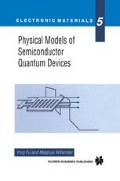Abstract
The intrinsic property of a crystal is that the environment around a given atom or group of atoms is exactly the same as the environment around another atom or similar group of atoms. To understand and to define the crystal structure, two important concepts are introduced, i.e., the lattice and the basis.
Access this chapter
Tax calculation will be finalised at checkout
Purchases are for personal use only
Preview
Unable to display preview. Download preview PDF.
References
P. Vogl, H. P. Hjalmarson, and J. D. Dow, “A semi-empirical tight-binding theory of the electronic structure of semiconductors”, J. Phys. Chem Solids, vol.44, p.365–78, 1983.
G. Dresselhaus, A. F. Kip, and C. Kittel, “Cyclotron resonance of electrons and holes in silicon and germanium crystals”, Phys. Rev. vol.98, p.368–84, 1955.
M. Tiersten, “Acoustic-mode scattering of holes”, IBM J. Res. Dev. vol.5, p.122–31, 1961.
W. P. Dumke, “Band-gap narrowing from luminescence in p-type Si”, J. Appl. Phys. vol.54, p.3200–2, 1983.
Y. Fu, S. C. Jain, M. Willander, J. J. Lofershi, “Valence band structures of heavily doped strained Ge x Si1-x layers”, J. Appl. Phys. vol.74, p.402–7, 1993.
H. Kroemer, K. J. Polasko, and S. C. Wight, “On the (110) orientation as the preferred orientation for the molecular beam epitaxial growth of GaAs or Ge, GaP on Si, and similar zincblende-on-diamond systems”, Appl. Phys. Lett. vol.36, p.763–5, 1980.
H. C. Casey, Jr, M. B. Panish, Heterostructure Lasers, Part B: Materials and Operating Characteristics (Academic New York 1978).
W. A. Harrison, Electronic Structure and the Properties of Solids (Freeman San Francisco 1980).
G. Margaritondo, A. D. Katnani, N. G. Stoffel, R. R. Daniels, T.-X. Zhao, “Nature of the band discontinuities at semiconductor heterojunction interfaces”, Solid State Commun. vol.43, p.163–6, 1982.
Author information
Authors and Affiliations
Rights and permissions
Copyright information
© 1999 Springer Science+Business Media New York
About this chapter
Cite this chapter
Fu, Y., Willander, M. (1999). Elemental and compound semiconductors. In: Physical Models of Semiconductor Quantum Devices. Electronic Materials Series, vol 5. Springer, Boston, MA. https://doi.org/10.1007/978-1-4615-5141-6_1
Download citation
DOI: https://doi.org/10.1007/978-1-4615-5141-6_1
Publisher Name: Springer, Boston, MA
Print ISBN: 978-0-7923-8457-1
Online ISBN: 978-1-4615-5141-6
eBook Packages: Springer Book Archive

